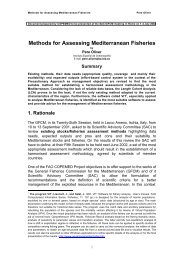Cours sur les méthodes d'évaluation acoustique ... - Fao - Copemed
Cours sur les méthodes d'évaluation acoustique ... - Fao - Copemed
Cours sur les méthodes d'évaluation acoustique ... - Fao - Copemed
You also want an ePaper? Increase the reach of your titles
YUMPU automatically turns print PDFs into web optimized ePapers that Google loves.
Cartesian coordinate system 2HistoryThe adjective Cartesian refers to the French mathematician and philosopher René Descartes (who used the nameCartesius in Latin).The idea of this system was developed in 1637 in two writings by Descartes and independently by Pierre de Fermat,although Fermat used three dimensions, and did not publish the discovery. [1] Descartes introduces the new idea ofspecifying the position of a point or object on a <strong>sur</strong>face, using two intersecting axes as mea<strong>sur</strong>ing guides. In LaGéométrie, he further explores the above-mentioned concepts. [2]It may be interesting to note that some have indicated that the master artists of the Renaissance used a grid, in theform of a wire mesh, as a tool for breaking up the component parts of their subjects they painted. That this may haveinfluenced Descartes is merely speculative. (See perspective, projective geometry.) The development of theCartesian coordinate system enabled the development of calculus by Isaac Newton and Gottfried Wilhelm Leibniz. [3]Nicole Oresme, a French philosopher of the 14th Century, used constructions similar to Cartesian coordinates wellbefore the time of Descartes.Many other coordinate systems have been developed since Descartes, such as the polar coordinates for the plane, andthe spherical and cylindrical coordinates for three-dimensional space.DefinitionsNumber lineChoosing a Cartesian coordinate system for a one-dimensional space—that is, for a straight line—means choosing apoint O of the line (the origin), a unit of length, and an orientation for the line. The latter means choosing which ofthe two half-lines determined by O is the positive, and which is negative; we then say that the line is oriented (orpoints) from the negative half towards the positive half. Then each point p of the line can be specified by its distancefrom O, taken with a + or − sign depending on which half-line contains p.A line with a chosen Cartesian system is called a number line. Every real number, whether integer, rational, orirrational, has a unique location on the line. Conversely, every point on the line can be interpreted as a number in anordered continuum which includes the real numbers.Cartesian coordinates in two dimensionsThe modern Cartesian coordinate system in two dimensions (also called a rectangular coordinate system) is definedby an ordered pair of perpendicular lines (axes), a single unit of length for both axes, and an orientation for eachaxis. (Early systems allowed "oblique" axes, that is, axes that did not meet at right ang<strong>les</strong>.) The lines are commonlyreferred to as the x and y-axes where the x-axis is taken to be horizontal and the y-axis is taken to be vertical. Thepoint where the axes meet is taken as the origin for both, thus turning each axis into a number line. For a given pointP, a line is drawn through P perpendicular to the x-axis to meet it at X and second line is drawn through Pperpendicular to the y-axis to meet it at Y. The coordinates of P are then X and Y interpreted as numbers x and y onthe corresponding number lines. The coordinates are written as an ordered pair (x, y).The point where the axes meet is the common origin of the two number lines and is simply called the origin. It isoften labeled O and if so then the axes are called Ox and Oy. A plane with x and y-axes defined is often referred to asthe Cartesian plane or xy plane. The value of x is called the x-coordinate or abscissa and the value of y is called they-coordinate or ordinate.The choices of letters come from the original convention, which is to use the latter part of the alphabet to indicateunknown values. The first part of the alphabet was used to designate known values.
















